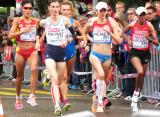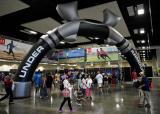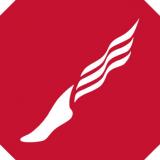Folders |
Armory Feature: A True PioneerPublished by
ANAHEIM, CALIFORNIA – Ted Corbitt was a true pioneer of his sport – in-oh-so-many ways. The late Upper Manhattanite – who passed away seven years ago at the age of 88 – was, let us take count: 1. The first African-American to run the Olympic marathon for Team USA (Helsinki in 1952). 2. A trailblazer in running races longer than 26.2 miles. He ran hundreds of them, all over the world, breaking records everywhere, and was the man who coined the term “ultra-marathon.” 3. A founder of the New York Road Runners Club, a president of the Road Runners Club of America, and an early national leader in the organization and promotion of the sport of running. 4. The man who "wrote the book" on accurately measuring road racing courses and trained a corps of certifiers who’d go on to follow in his footsteps. 5. A physical therapist who worked wonders in creating paths to rehabilitation and fitness and never ceased studying and promoting advances in his career field, giving the gifts of improved health, mobility and quality of life to many thousands. 6. And while doing all this, he was the proudest of Pioneers – that’s Pioneer with a capital “P” – as a celebrated member of one of the nation’s most notable track and field clubs, the New York Pioneer Club. For all these reasons – and likely a whole lot more – Ted Corbitt was recently inducted into the National Track and Field Hall of Fame, which is located in New York’s Armory Track Center. “My father had so many amazing accomplishments,” said his son, Gary, before the formal phase of the ceremonies began at the Annual USA Track and Field meeting. “But as I talk to more and more people, I learned about the way he helped them, both in his physical therapy practice and in providing inspiration. The ways he inspired people became most important to me; that was really moving to me." It seems that Ted Corbitt never really ran at The Armory (which in his day was called the 102nd Engineers Armory); basically because they never had a race there long enough for him. To some, a three-mile run might seem a distance race; to Corbitt it was just an extended sprint. He did, however, run past the Armory many a time on his frequent tours of the perimeter of Manhattan Island. "Ted Corbitt, an elegant man, spoke softly but pierced the boundaries of human experience," said Armory Foundation president Dr, Norbert Sander. "Who of us at Van Cortlandt Park watching him pass on Saturday morning in the 1960’s as he ran by on his way to circling all of Manhattan Island, could imagine he was preparing for a 100 mile run in England. When we thought three miles was a distance workout, Ted was on to five and six hours of continuous running.” Corbitt’s idea of a good interval workout was two laps around the island’s 31 miles. He also ran a lot of laps around the 220-yard track of another Manhattan armory – the drillshed of the famed 369th AAA – often known as the Harlem Hellfighters Regiment. The 369th AAA Armory, located at 142nd Street and Fifth Avenue, was the home of the New York Pioneer Club, coached by the legendary Hall of Famer Mr. Joseph Yancey Jr. and his loyal assistant and eventual successor, Mr. Ed Levy. The Pioneers were true democracy in action, as a club open to all comers, regardless of race, creed, religion, or ethnicity – in an era when some other clubs were “drawing the line.” And Ted Corbitt reveled in this enlightened “we’re all one” atmosphere – where his Pioneer teammates included such fellow Hall of Famers as Bob Beamon, John Carlos, Vince Matthews and Steve Williams and Olympians Gordon McKenzie, Reggie Pearman, Irv "Moon" Mondschein, Marty Engel, George Shaw, Rudy Haluza, Keith Gardner, Ed Conwell, Ken Bantum, Bruce MacDonald, Jim Gathers and Mike Shine. Many track fans of the day thought of those Pioneers as “a sprint team,” but the truth was that the Pioneers were road racing kings of their day, too, with such notables as McKenzie (a two-time Olympian), Rudy Mendez, Dr. Charley Robbins, John Sterner, Rod MacNicholl, John Conway and many more as Corbitt’s teammates, who collected national road racing team titles in profusion, year after year after year. “Yes, Dad must have run past The Armory many times, all the time,” said son Gary. “He’d have two routes around Manhattan, clockwise or counter clockwise, he’d just alternate them for a change of pace." Labor Day weekends were special to Corbitt. Some of them he’d run twice around Manhattan Island – plus a little bit more – sometimes up to 70 miles. And sometimes he’d do it three days in succession. With all that mileage under his belt, something, some body part or other, would have to give – and often did. “So Dad would often run injured a lot,” said Gary. “But he’d always find a way to patch himself up, to get up the next day and do it again. And the next day after that.” In later years, in his early 80s, when running became too difficult, Corbitt turned to walking and in one memorable six-day stretch went on to cover over 300 miles as a Big Apple pedestrian. David Katz of Port Washington, N.Y., recognized now as the world’s leading course technician, gave all credit to Corbitt for leading him in this direction. And for codifying so much about road running that previously was no more than an educated form of guesswork. “Ted invented the sport of road racing, and do you know why?” asked Katz. “When you go out and play as a kid, and you throw the ball, or you run down the street, that is play. But when you say,' I’m going to run down to the fire hydrant, turn around and run back,' that becomes a sport. That’s not play anymore.” Born Jan. 31, 1919 in segregated South Carolina – Corbitt learned to love distance running as a youngster growing up in a rural, farming community. He’d serve in the U.S. Army in the latter stages of World War II's Pacific campaign, in Okinawa, then elsewhere in the Pacific at war's end. He enrolled at the University of Cincinnati - running mile and two-mile races for the Cinci track team while gaining his bachelor's degree - and then gained a Masters at New York University in physical therapy. Ever a student of the healing arts, he’d forever be enrolled in advanced therapy courses at Columbia and NYU. But he always found time for the running activities, which would became his ongoing passion. Ted Corbitt has been gone for nearly seven years now but you can still visit him in at least a pair of ways. First, there’s Ted Corbitt Way – a section of West 228th Street in his old Manhattan neighborhood – that is in place as the city’s tribute to its “runningest” man. Second, there’s TedCorbitt.com, where his epic story comes to life in digital form. And shortly, soon as The Armory installs the tributes to its National Track and Field Hall of Fame Class of 2014 – hammer/weight thrower Lance Deal, pole vaulter Stacy Dragila, late-great Olympic sprinter Thomas Burke and hammer/weight champion Patick “Pat” Ryan, along with Corbitt – you’ll be able to step into the Fort Washington Avenue building and marvel at this man’s achievements all over again.
By Elliot Denman More news |








